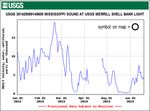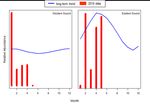2019 Bonnet Carré Spillway Monitoring Update
←
→
Page content transcription
If your browser does not render page correctly, please read the page content below
2019 Bonnet Carré Spillway Monitoring Update
June 21, 2019
• Oyster mortality on Mississippi harvest reefs ranged from 87% to 100% based on MDMR sampling for the week of June 10
(Figure 1). Mortality was higher than 90% for all reefs with the exception of Pass Marianne.
• As expected, oyster mortality on all Mississippi harvest reefs has gradually increased over time as the Bonnet Carré spillway
remains open (Figure 2).
• Commercial landings of blue crabs in Mississippi in 2019 were down between 25% and 45% for February through April
compared to the prior 5-year average (Figure 3). Landings for May increased and were similar to prior five years.
• At its June meeting, the Mississippi Commission on Marine Resources used an emergency provision in the Mississippi Code
(49-15-64.1) to open shrimping in permitted State waters prior to the legal benchmark for the traditional season opening being
reached (i.e., 68 shrimp per pound threshold).
• An opening day assessment of shrimp season conducted by MDMR (June 20) noted 133 shrimp boats fishing in Mississippi
waters, with most of the effort (89 boats) being north of Horn Island; only three boats were observed west of the Gulfport Ship
Channel in Mississippi waters. Interviews with shrimpers indicated that overall catch was low.
• The catch of brown shrimp in state monitoring trawls is down more than 82% for the past four weeks compared to the prior 5-
year average (Figure 4).
• Abundance trends for spotted seatrout sampled as part of ongoing monitoring efforts show a decrease at stations to the west
(nearer the Bonnet Carré) relative to the long-term average, while trends at eastern stations are generally comparable to the
long-term trend (Figure 5).
• The frequency of dolphin and turtle strandings has decreased considerably in June. For the week of June 16, no dead
dolphins and one dead sea turtle have been encountered/reported. For 2019 (through June 20), 130 dolphins and 156 sea
turtles have been found dead along the Mississippi coastline (Figure 6). The MSU College of Veterinary Medicine is working
with IMMS to assess possible causes of mortality and general dolphin health issues.
• An expedited seagrass survey was conducted at Cat Island on June 17, during which USM researchers made their first
observation of widgeon grass, a low salinity species, since monitoring at those stations began in 2011.
• Expanded water quality sampling by USM on June 13 showed surface salinity levels were low in the western Mississippi
Sound (Figure 7) and corresponded to remote sensing data of Bonnet Carré sediment discharge for that date (Figure 8).
• Salinity levels in the central Sound had shown a general increase during the week of June 9. This was attributed to
a shift in wind direction to from the north at the time, which allowed spillway discharge to release more directly to the
south (Figure 8).
• With the return of generally southerly wind flow this week, salinity levels in the Mississippi Sound are decreasing again
(Figure 9), as the south winds push surface waters to the north and entrap spillway discharge in the Mississippi Sound
with greater effect.
• Backtracking estimates produced by NOAA for sea turtle strandings documented along the Mississippi coastline
and in adjacent waters (01/15/19 to 06/06/19) suggest a wide geographic range of areas of likely mortality, including
the Mississippi Sound, Chandeleur Sound and neighboring Gulf waters (Supplement 1). Backtracking estimates for
Mississippi dolphin strandings will be conducted by the state partners when data are supplied.
Report any unusual observations associated with the Bonnet Carré spillway opening to the USM Hotline at 228-818-8099.
Dolphin and turtle strandings should be reported to the IMMS 24-hour hotline at 888-767-3657.2019 Bonnet Carré Spillway Monitoring Update
June 21, 2019
Figure 1. Numbers of live and dead oysters collected on Mississippi harvest reefs for the week of
June 10, 2019. Blue bars represent number of live oysters collected, and red bars represent dead
oysters. Percentages represent reef-specific mortality estimate [(total number dead / total number
collected) x 100]. Source: MDMR
Figure 2. Percent mortality for Mississippi harvest reefs since the opening of the Bonnet Carré spillway.
Percent mortality = (total number dead oysters / total number oysters collected) x 100. Source: MDMR
Report any unusual observations associated with the Bonnet Carré spillway opening to the USM Hotline at 228-818-8099.
Dolphin and turtle strandings should be reported to the IMMS 24-hour hotline at 888-767-3657.2019 Bonnet Carré Spillway Monitoring Update
June 21, 2019
Figure 3. Commercial landings of blue crabs in Mississippi for the months of January through May for the
prior 5-year average (blue) compared to 2019 (red). Source: MDMR
Figure 4. Catch per unit effort (weight per 10-minute trawl tow) of brown shrimp by sampling week in the
Mississippi Sound for the prior 5-year average (blue) compared to 2019 (red). Source: MDMR
Report any unusual observations associated with the Bonnet Carré spillway opening to the USM Hotline at 228-818-8099.
Dolphin and turtle strandings should be reported to the IMMS 24-hour hotline at 888-767-3657.2019 Bonnet Carré Spillway Monitoring Update
June 21, 2019
Figure 5. Long-term trends in relative abundance (blue line) for spotted seatrout from fishery-
independent monitoring in the western (left) and eastern (right) Mississippi Sound and adjacent bays.
Red bars represent 2019 estimates of relative abundance from respective stations. Source: MDMR/USM
Figure 6. Mississippi bottlenose dolphins strandings by month for 2014 through 2019; 2019 data are
through June 20. Source: IMMS/MDMR
Report any unusual observations associated with the Bonnet Carré spillway opening to the USM Hotline at 228-818-8099.
Dolphin and turtle strandings should be reported to the IMMS 24-hour hotline at 888-767-3657.2019 Bonnet Carré Spillway Monitoring Update
June 21, 2019
Figure 7. Depiction of salinity levels in the Mississippi Sound for June 13, 2019, as extrapolated from field data at expanded water
quality stations (yellow squares). Note that field data validate interpretation of deep red colors on satellite imagery (below) as zones
of less than approximately 5 ppt salinity. Source: USM
Figure 8. Satellite imagery of the distribution of river-borne sediments at the surface of coastal waters of
the northern Gulf for June 13, 2019. Imagery supports observations of reduced spillway-related freshwater
effects in the central Sound last week in association with general northerly wind flow. Source: USM
Image Interpretation: Warmer colors (yellow to red) represent the extent of freshwater influence from diverted river waters from
the Bonnet Carré spillway discharge in the western Mississippi Sound. Deep red colors are generally representative of salinities
less than 5 ppt, and blue colors represent high salinity waters.
Report any unusual observations associated with the Bonnet Carré spillway opening to the USM Hotline at 228-818-8099.
Dolphin and turtle strandings should be reported to the IMMS 24-hour hotline at 888-767-3657.2019 Bonnet Carré Spillway Monitoring Update
June 21, 2019
Figure 9. Daily salinity measurements from January 1 to June 20, 2019, at USGS/MDMR gauges in the Mississippi Sound.
Source: USGS/MDMR
Report any unusual observations associated with the Bonnet Carré spillway opening to the USM Hotline at 228-818-8099.
Dolphin and turtle strandings should be reported to the IMMS 24-hour hotline at 888-767-3657.Supplement 1. 2019 Bonnet Carré Spillway Monitoring Update - June 21, 2019. Source: NOAA
Sea Turtle Stranding Locations and Heat Map Backtracks to Likely
Mortality Origins from January 15 to June 6, 2019
a
at
D
y
ar
in
Summary heat map of sea turtle backtracks to possible mortality origins in Mississippi from January
im
15 to June 6, 2019. The model is based on ocean winds and currents, as well as reported carcass
condition codes (fresh dead, moderately decomposed, severely decomposed) and probable
decomposition sequence to float time using water temperature and ocean depth. Sea turtle stranding
el
sites (n=139) shown as blue triangles.
Pr
Interpretation: White is zero possibility of mortality origin, areas shaded in cooler colors (blue to green)
represent areas where sea turtle mortality was possible but the probability is low. Warm colors (yellow-
orange) represent areas where the mortality origins are moderate, i.e. about 50% possible. Areas
shaded in dark red to black are locations where sea turtle mortality very likely originated.
Results prepared by the NOAA Southeast Fisheries Science Center, Mississippi Labs and NOAA
National Centers for Environmental Information, Stennis Space Center. Contact Dr. Melissa Cook,
Mississippi Sea Turtle Stranding & Salvage Network Coordinator (Melissa.Cook@noaa.gov) for
additional information.You can also read


























































